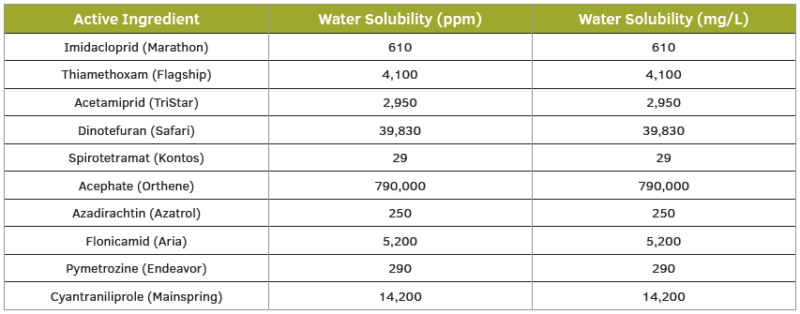Water Solubility and Systemic Insecticides
Question: What is the relationship between water solubility and systemic insecticides?
Answer: Excellent question. First of all, what is water solubility? Water solubility is a measure of the amount of chemical substance (insecticide) that will dissolve in water at a specific temperature (e.g., 68º F) or pH (e.g., less than 7, 7 or more than 7). Water solubility is expressed as ppm (parts per million) or mg/L (milligrams per liter), and is classified as low (less than 10 ppm or 10 mg/L), moderate (10 to 1,000 ppm or 10 to 1,000 mg/L), or high (more than 1,000 ppm or 1,000 mg/L).
In general, systemic insecticides must be water-soluble to some degree, which allows the dissolved active ingredient to move into the root zone when applied to the growing medium, and then be absorbed by plant roots, and consequently translocated throughout the plant. The water solubility of commercially available systemic insecticides used in greenhouse production systems are presented in Table 1.

Water solubility determines how rapidly the active ingredient is absorbed by roots and translocated within the plant and deposited into plant parts such as leaves and stems. In general, a high water-soluble systemic insecticide will kill insect pests (e.g., aphids and whiteflies) more rapidly but may not provide long-term or sufficient residual activity (persistence) compared to a low water-soluble systemic insecticide. For example, dinotefuran (Safari, Valent USA Corp.) is more water soluble (39,830 ppm or 39,830 mg/L) than imidacloprid (Marathon, OHP Inc.), which has a water solubility of 610 ppm or 610 mg/L; consequently, dinotefuran is more readily available in the growing medium for root uptake and translocation throughout plant parts than imidacloprid. Therefore, any delay or lag time from application to full systemic translocation within plants may affect the ability of the systemic insecticide to prevent the development of future generations. However, higher label rates may result in longer residual activity.
A low water-soluble systemic insecticide may have a longer residual activity, but may not be effective in suppressing insect pest populations unless the rate is adjusted to compensate for the slower mobility or the systemic insecticide is applied earlier in the production cycle.
High water-soluble systemic insecticides are more susceptible to leaching although there may be considerable variation in the solubility/leaching potential. For instance, leaching is influenced by watering techniques and growing medium composition that is affiliated with binding to the active ingredient, which can reduce the leaching potential.
Growing media containing a high percentage of organic matter, such as those with less than 30 percent bark and/or peat moss will bind to the active ingredient of certain systemic insecticides including imidacloprid and dinotefuran. The binding of systemic insecticides can reduce the amount of active ingredient absorbed by plant roots, resulting in insufficient of suppression of insect pests.









 Video Library
Video Library 


















